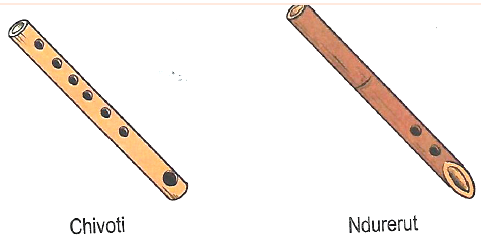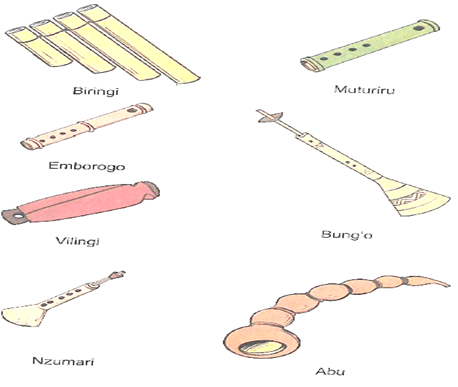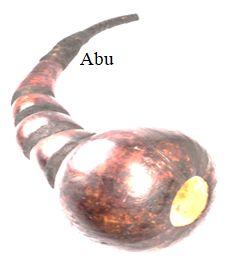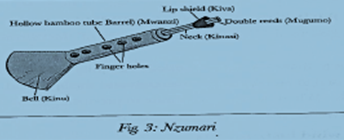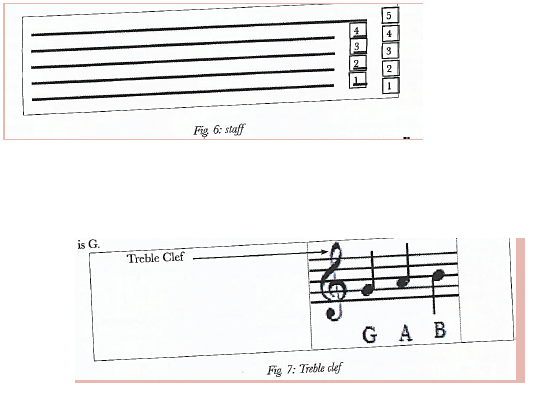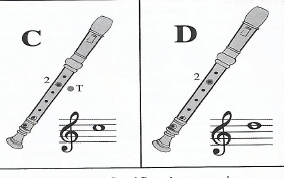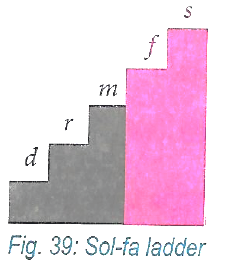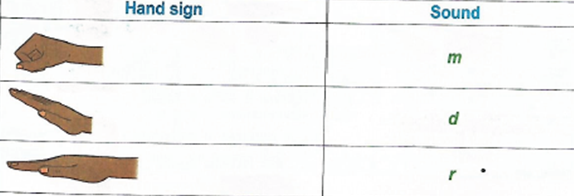
Wind Instrument
- They are also called aero phones. They are played by blowing
These instruments have a permanent tuning which is acquired during construct - This is because upon constructions, wind instruments remain of fixed length, have a fix number of holes and a fixed blowing hole.
- They vary in shape, size and material used to make them. They are grouped in the following sub- classes”
- Horns- made from animal horns or natural hollow or hollowed out wooden tubes. Among some communities horns are joined to a gourd. E.g.
- Oluika- luya
- Lalet-kalenjin
- Oporo/tung’-Luo
- Coro-kikuyu
- Kikundit-kipsigit
- Adet-turkana
- Aluti-Teso
- Flutes-Are made from materials such as bamboo, swamp reeds, twig or wooden tubes. Currently improvised using plastic tubes.
Flutes vary in length and number of finger / pitch holes from one community to another.
Other features that can be used to distinguish or differentiate flutes are:
- closed at both ends
- Open at both ends
- Open at one end and closed at another end
- Notched at the blowing end (part of the end is v-shaped)
- Round at the blowing end
- End blown (also oblique)
Side blown (also traversely blown-this means the blowing hole is at the side of the flute.)
Indigenous flutes from the diverse Kenyan communities include:
End blown flutes (oblique)- Muturiri-Gikuyu
- Auleru-Teso
- Asili/Odundu-Luo
- Ndererut-Kalenjin
- Ebune/Elamaru-Turkana
Traversely held flutes - Chivoti-Digo, Rabai, Duruma
- Ekibiswi-Kuria
- Emborogo-Kuria
- Umwere-Kuria
- Mulele-Luhya
- Whistles – these wind instruments are made from hollow tubes or reeds which are bound together. The different length makes it possible to produce different varied pitches when the instrument is blown e.g. biringi of Agikuyu, vilingi of the Akamba.
- Reed instruments – double reed instruments have two reeds at the mouthpiece which is made from reeds. The two reed instruments have a tip shield made out of a coconut shell of metal coin
The lip shield- holds the reed in place and prevents air from escaping. The reeds vibrate when air is blown into the instrument thus producing sound. The Nzumari and the Bung’o played among some of the mijikenda community such as Digo and Rabai.
Functions of parts of flutes
- Bamboo reed - this is the main framework of the instrument and it also serves as the resonator
- Blowing hole – it is a hole through which air is blown causing the production of sound
- Pitch hole – are closed and opened with alternating finger movements to produce varied pitch when playing the melody.
- Closed – end = this part direct the sounds towards the open end.
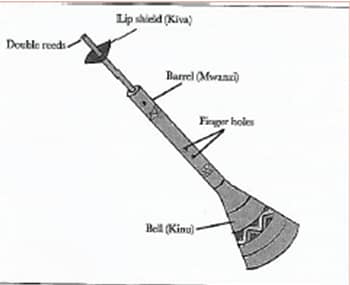
FUNCTIONS OF THE PARTS OF REED INSTRUMENTS
- Hollow bamboo reed – this is the main body of the instrument which act as a resonator
- Bell - it is used to make the sound louder or amplify the sound
- Neck - use to attach the double reeds and the lip shield
- Double reeds - when blown, they vibrate to produce sound
- Lip shield – this is where the lip rest when blowing
SKILLS OF PLAYING WIND INSTRUMENTS
- Some are held traversely while others are end blown
- Positioning of the lips – the lower lip is placed on the lower part of the blowing hole
- Blowing- air should be blown across the blowing hole. The amount of air being blown depends of the wind instrument.
- Tonguing - the tongue is used to put the accent on
- Fingering – closing and opening of finger holes in an alternating manner assist to produce varied pitch.
- Breath control – it’s also referred to as phrasing and should be done at appropriate places when playing the wind instrument.

Western Musical Instrument
Descant Recorder
Recorder fingering chart
Skills of playing the recorder
- Posture – correct poster will help in breathing deeply in order to get good sound out of the recorder.
- Breath control – enables them to achieve the good phrasing when playing the descant recorder.
- Holding – should be held properly with both left handed and right handed learners. The recorder is end blown.
- Embouchure - refers to the position and the use of the lips and teeth in playing wind instrument. It includes shaping the lips to the mouthpiece of the musical wind instrument
Embouchure is important because it affect the production of quality of sound - Articulation – (preparing the tongue) air flow is critical to the production of good tone or sound on the descant recorder. Blowing too much air will leard to production of squeaking sound.
- Fingering – the left hand should be placed in the first three holes, while the right hand should be placed in the rest of the holes. Holes should be covered completely, failure to which will cause air to escape and a squeaking sound will be produced.
When holes on the descant recorder are covered completely, small round marks will be imprinted on the fingersTHE NOTES B, A AND G
They are played using the left hand and are organized logically with fingers moving in a sequential order.
Music Staff Notation
THE STAFF- this is a set of five parallel line and four spaces on which music is written.
The lines and spaces are named using the seven letters of the English alphabets A,B,C,D,E,F, and G.
Naming is made possible using clef. The treble or G clef is used to establish the pitches of the staff
Music for the descant recorder is written on the staff using the treble Or G clef.
Fingering notes is illustrated below
NEW NOTES C AND D
- They are fingered using the left hand as shown below
- The left hand thumb hole is left open when playing the note D

Kenyan Folk Dances
Dance - a form of art involving rhythmic movement’s f the body in response to music
It is an expression of norms, values, belief, attitudes and customs of the community.
In traditional African society dances are for specific groups of the performance e.g. boys, girls, boys and girls, young women and
Categories of participants
- Soloist – introduces dances, it is also known as Solo choral response or call response singing.
Roles of a soloist- Starting the dance
- Ending dance
- Help capture the message and the mood of the dance
- Pitching the dance songs
- Cuing dance on the change of melodies, movements and dance formations.
- Dancers – perform dance movements, create formations
- Dancers – perform dance movement. create formations
- Lead dancers – remind dancers the next dance style and formation. Guide other dancers in creating the varied dance styles/movement and formations to ensure transitions to ensure transitions are smooth.
- Singers - respond to the call of soloist. Make performance lively. Communicate the message and the mood of the dance
- Instrumentalist – make the dance performance lively.
Melodic instrument helps in pitching the performance.
Help in keeping the steady beat of the songs.
Assist to cue singers and dancers on the change of melodies, dance styles and formations to ensure smooth transition.
Provide rhythmic and melodic support to the rhythms and melodies in dance. - Audience and onlookers – make participants feel appreciated
Their participations bring the dance to life
Costumes
This involves styles of dress or clothes worn by the participants in dance performance. Roles of costumes in dance performance include:
- To depict the cultural community it is drawn from.
- To adorn the participant
- To distinguish the different roles played by various participants of the dance
- Influence the participant level of confidence
- Allow dancers or the wearers freedom of movement and formation
- Give information about certain role or characters due to elaborate details of the costumes
- They give the participant of the dance aesthetic appeal
- Are associated with the costumes and habits of a group of people
- Gives the participant dignity
- Help the identify the community the song originates from
- Create uniformity among the participant
- In modern times dance performance use uniform costumes made of sisal and banana leaves
- In each community there are items of value which the participants use during dancing. These items are also known as artifacts which includes shields, swords, skis and traditional tools.
Body Adornment
- It is an art which involved decorating the body, these vary across communities and can be permanent or temporary
- Permanent body adornment is done by piercing, scarification or tattoos, both are used to enhance beauty and also have social and ritual significance
- Some adorn using temporary designs using pain, ochre and henna to decorate the skin. The decoration can symbolize a variety of meaning e.g. social, economic or marital or even political status of the wearer.
- In some communities it is used to enhance the feminity or masculinity of an individual.
- The most common method used nowadays is by water emulsion pain
The type of body adornment used is influenced by the occasion /event or an individual’s stage in life.
Ornaments
Are accessories, articles or items used to add beauty or decorate the appearance of the participants in dance.
In some communities’ beadwork is an integral part of making ornament, beads used in making ornaments can vary in shape, size and colour. The ornaments include.
- Earring
- Armlets/armbands
- Anklets
- Necklaces
- Feathers

Creating /composing
Is a succession of sound with long, short or equal duration. It is the pattern of the music in a given time. It can exist without a rhythm.
The long and short the French rhythm names are used to create different rhythms and represented by different matching symbol. These musical symbol are the musical notes.
| French rythm name | Length of sound |
| Taa | 1 long sound |
| Ta-te | 2 long sounds |
| Taa-aa | 2 long sounds |
| Taa-aa-aa-aa | 4 long sounds |
| French rythm name | Note symbol | Note name | Length of sound | Number of beats |
| Taa | |
Crochet | 1 long sound | 1 beat |
| Ta-te | |
Quavers | 2 long sounds | ½ a beat for each quaver |
| Taa-aa | |
Minim | 2 long sounds | 2 beats |
| Taa-aa-aa-aa | |
Semibreve | 4 long sounds | 4 beats |
Words have their natural speeches style which dictates whether to be given either along or a short beat. Syllables in words can be stressed while others are not.
The stressed syllables occurs as strong beats while the unstressed syllables as week beats.
The beats are divided into groups of two beats, three beats or four beats
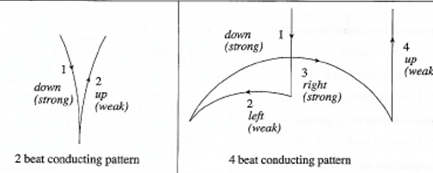
Melody
Is a sequence of pleasant sounds that makes up musical phrase
It is a tune that sound nice or pleasant to the ears
An understanding of high and low sounds is essential in identifying melodic variations within a song. Variation to simple melodies can be created by
- Repetition
- Changing doh
- Changing rhythms
- Changing note
- Changing words
Hand Signs
It is a good way of understanding and recognizing pitch. These are gestures used to indicate pitch in sol –fa.
When using hand gestures to guide the pitch of the ‘’doh’ is movable (it is not fixed)
Hand signs showing sol-fa syllables
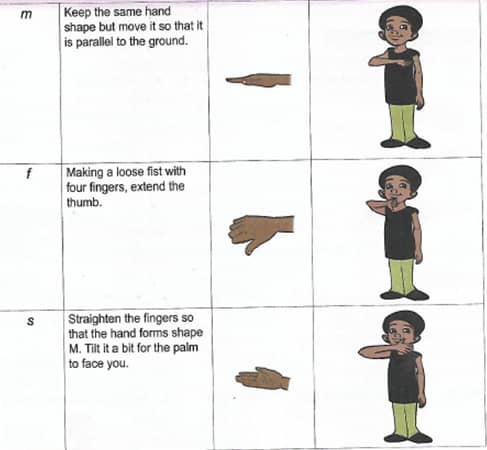
Hand signs showing sol-fa syllables
Download Kenya Indigenous Musical Instrument - CBC Grade 5 Music Revision Notes.
Tap Here to Download for 30/-
Get on WhatsApp for 30/-
Why download?
- ✔ To read offline at any time.
- ✔ To Print at your convenience
- ✔ Share Easily with Friends / Students

